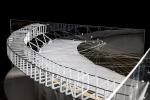Seven Trends That Are Shaping Building Information Modelling
Building Information Modelling (BIM) has gained traction. Its focus on sustainability and shared work environments is key. These are the trends that will shape BIM in the coming years.

The architectural and engineering industries have changed dramatically in recent years. New technologies, such as virtual reality and 3D printing, open up new possibilities. You now have more tools at your disposal for helping clients to work out what you’re explaining to them.
The way we build structures and buildings has also changed. There’s a greater focus on sustainability. Plus, efficiency is key. All in the sector are more cost-concerned than ever. New technologies pave the way for more efficient service, which lowers costs.
Cloud computing is one such technology too. Web-based storage encourages collaboration between teams and clients on a grand scale. The rise of the cloud also led to the development of new methodologies, such as Building Information Modelling (BIM).
BIM has gained popularity in recent years. Many governmental organisations now look for the methodology in the tenders they accept for new projects. BIM combines digital design software, the cloud, and new techniques to create a new method. What BIM is not is a digital design software itself.
Today, BIM is one of the leading drivers in the architectural and engineering sectors. Naturally, there are several trends that will shape the method’s future as it evolves. Before looking at those, let’s take a more in-depth look at what Building Information Modelling has to offer.
Explaining Building Information Modelling
You already know that BIM is a methodology, not a design software. But you may not understand what that means.
At its core, BIM combines a collaborative work structure with sustainable building design. It also places a huge emphasis on data. The data that you collect informs the models that you build in the BIM methodology. Furthermore, BIM software allows for the use of this data across several models and drawings. In many cases, a change in one model leads to automated changes in any that link to it.
There are many benefits of BIM for engineers and architects. These include the following:
- Less Repetition: Generally, BIM software doesn’t require you to re-enter data every time you build a model. You need only enter the data once, and the software uses that data for every model related to the project. Furthermore, BIM’s focus on collaboration means it leverages the data that others contribute. Getting all stakeholders involved early creates a more informed working environment. BIM facilitates this, cutting down on repetition and increasing efficiency in the process.
- Clash Detection: All of your work comes together in the Building Information Modelling method. As a result, you’re more likely to detect clashes that may have gone unnoticed with other methods. This has two benefits. For one, it allows you to spot small mistakes before they become major problems. You won’t get most of the way through a model before noticing the error when using BIM. Early clash detection also benefits construction crews. They won’t have to start work using faulty models, which drives efficiency up.
- Lower Costs: It does take some spending to adapt to BIM. You may need new software and training. However, less reworking means that you save money on every project. Plus, you’re less likely to make errors that lead to ordering too many materials.
The Trends Shaping BIM
Building Information Modelling is a trend itself. In fact, it’s one of the largest trends in the industry right now. However, as with many large trends, there are a few smaller trends that affect it. There are seven BIM trends to look out for.
Trend #1 – The Rise of 3D Printing

It’s only been a few years since everybody saw 3D printing as a novelty. Sure, it’s cool that you can print out objects. However, the results weren’t always satisfactory. Early 3D printing had its limits. Materials looked rough, and the costs prevented most from adopting it.
That’s all changed. Today, 3D printing is one of the best ways to turn your digital model into something real. Combined with BIM, you can create accurate scale models with a 3D printer.
According to Forbes, the 3D printing industry will generate over US$12 billion (Approx. AU$15.3 billion) in 2018. Most of that will come from prototyping.
What are your physical scale models if not prototypes?
3D printing also shares BIM’s focus on sustainability. Its additive method leads to less material waste when producing physical models. This gels with the sustainability at the core of the BIM model. Saving money and materials leads to greater efficiency, which saves money for you and your clients.
BIM software also plays a role. With 3D printing, you can port the data from your models directly to your printer. There’s no messing around with tooling or materials. The printer handles all of that for you.
Over the coming years, 3D printing will become a crucial part of the BIM method.
Trend #2 – Improved 3D Laser Scanning

Let’s stick with the 3D topic and look at laser scanning. 3D Laser scanning allows you to capture relevant information about existing structures. This includes factors like appearance and shape. Importantly, the scanner then converts this information into a set of data points. You can import this into your BIM software. An hour of scanning can provide data that may have taken you days to measure manually.
So, why hasn’t laser scanning already become a part of Building Information Modelling? As with many new technologies, it all comes down to cost. Currently, 3D laser scanning can be a huge investment, especially for small firms.
However, even today that investment repays itself. Laser scanning saves valuable work hours that you can dedicate elsewhere. It’s also not prone to the human error that can delay projects.
On top of that, laser scanning improves field safety. It doesn’t require people to clamber all over structures to get their measurements. You just set up the scanner and let it get to work.
Laser scanning improves efficiency and lowers project costs. As the technology improves, so will the prices. As that last barrier to entry crumbles away, laser scanning will become a top technology trend in BIM.
Trend #3 – The Growth of Prefabrication

Prefabrication (prefab) is already a growing trend in the construction industry. It allows for the creation of vital materials before a project begins. Instead of waiting until just before a project begins to make materials, you can have them ready to go from day one. Construction crews benefit from lowers costs and greater efficiency.
You can see from that how prefab and Building Information Modelling mesh. However, it goes deeper than that. BIM allows you to create basic building models. It also lets you build thermal models and make calculations relating to the structure. BIM accounts for any important data during the modelling process.
This wealth of knowledge aligns BIM with prefab. Knowing what you need well in advance of construction allows you to get your materials in order early. It gets your construction crews involved from the start too. Instead of waiting for building to begin, crews can get their materials in order early on. They can also skip the verification process that usually takes place on-site.
Finally, BIM software helps you to optimise your structures. You’ll identify inefficiencies and scratch them out before building begins. All of this lends itself to the growing prefab trend.
Trend #4 – Faster Energy Modelling
The concept of energy modelling is not a new thing. You may have been creating energy models for years. Examples include airflow models, which can take weeks to create and test. Those who don’t create them often hire people who can. This adds more costs to their projects, as well as making work less efficient. All of this hinders the design team during the project’s conceptual phases.
However, the rise of Building Information Modelling has brought with it some new software packages. Autodesk is a good example. The company offers FormIt, a software package that allows you to create energy models for your early concepts. Aligning to conceptual models means you don't have to wait for energy models. You catch issues early on, and can make adjustments to the model as needed.
This earlier energy modelling produces more data. As time goes on, you’ll likely be able to import this data into your BIM software. Again, this will lead to energy modelling becoming part of the BIM process, rather than a standalone task.
Trend #5 – The Mobile Market

The rise of mobile devices affects every industry. As these devices become more powerful, both project teams and clients expect greater portability. Now consider the cloud-based technology that BIM software uses. Cloud technology allows sharing across multiple devices, all connected to the cloud.
Naturally, mobile devices and BIM mesh together. You may already see this in action, as many BIM software packages have mobile components. These may allow you to access your models, so you can show them off without lugging your computer around. Mobile also opens the door for instant communication and better collaboration. Again, this serves the purposes of BIM.
The key is that mobile makes your work accessible from anywhere in the world. It allows for easy access and sharing. This improves productivity, again leading to those all-important cost reductions.
As mobile devices advance, you may find yourself using them to sketch initial concepts. More work will move away from the desktop. However, everything will link through the cloud-based BIM method.
Trend #6 –Modular Manufacturing
Many believe that Computer Numerical Control (CNC) fabrication is falling by the wayside. Some point to Computer-Aided Manufacturing (CAM) as the new big thing. The mention of the word “computer” should tip you off to the link with BIM.
CAM allows for modular building designs. It can take in data from BIM software and create standardised materials usable across several projects. Compare this to CNC, which requires a greater degree of manual control.
Many see modular as the way forward for construction. It allows for the creation of standard structures using prefab materials. This increases efficiency and lowers costs. The combined rise of prefab and modular design meshes well with BIM because of this.
Trend #7 – Energy Efficiency
The world is more environmentally-conscious and there's a trend towards green construction. Going green offers several opportunities to your clients. They can use it as a badge of honour. In this context, being green is as much a marketing tool as it is an effort to save the environment.
However, green buildings also save money. Clients spend less on energy and waste disposal. Even if you disregard the marketing opportunities, going green is a good thing for most businesses.
As a result, today’s architects and engineers design towards energy efficiency. This is where BIM comes in. Improved energy modelling and more data inform your design choices. You can create energy-efficient buildings with greater ease when using the BIM method.
The desire for green construction will lead to more people adopting BIM.
Conclusion
BIM is still one of the largest trends in the industry. As a result, smaller trends have the potential to shape it. Each of the seven mentioned above are in the process of changing how BIM works. Most mesh with the method because of a focus on efficiency or sustainability. As the technology behind these trends improves, you’ll likely see each become an important part of the BIM method.
These trends also affect the construction industry at large. As they gain popularity, clients will expect you to follow them. This means that these trends not only shape how BIM works, but will also shape its popularity in the coming years.
BIM is still in its early stages. You have the opportunity to make the transition now, but you need the right training and software. That’s where ArchiStar Academy can help. We offer several BIM software courses that can help you incorporate these trends into your work. ArchiStar Academy also offers courses in an array of digital design software, including BIM-focused software like Revit.
Do you want to learn more about how ArchiStar Academy can help you switch to BIM? Get in touch now and we’ll provide the software training you need to build models using BIM.
ArchiStar Academy offers several courses across the spectrum of digital design software. You’ll develop your skills, allowing you to create more accurate and functional models.
Please don’t hesitate to get in touch with Archistar Academy today if you have any questions.
If you would like to share your thoughts on our blog, we’d love to hear from you!
Get in touch with the ArchiStar Academy [dev] community via Facebook.
Posted on 20 Jan 2020
![ArchiStar Academy [dev] logotype](https://academy.archistar.io/images/archistarr-academy.png)